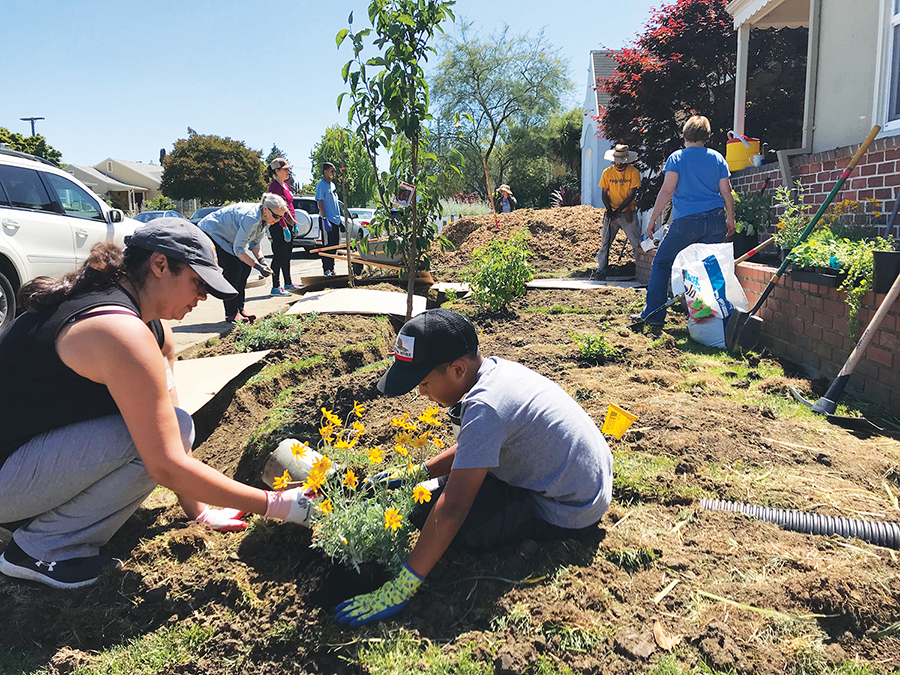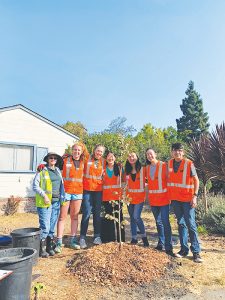
Jessica Sanchez and her son Dominic work on a lawn conversion with the Resilient Neighborhoods program. Photo courtesy Sustainable Solano.
Resiliency has become a buzzword in recent years, and with good reason — it’s a useful term to describe the ability of a person or a place to confront, and even thrive in, the environmental swings of climate change. Open space and parks provide this vital kind of resiliency through ecosystem services, the wide range of ways that nature benefits humans. Such ecosystem services can be cultivated on landscapes of a smaller scale as well: Homes, schools, and neighborhoods can also help to build healthy soil, grow food, sequester carbon, capture water, support biodiversity, and provide shade and moisture.
Several cities and organizations across the Bay Area are working to help communities become more resilient by applying this logic. In one example, the nonprofit Sustainable Solano has recently launched a new program called Resilient Neighborhoods. The launch started with three homeowners in Vallejo who made simple, low-cost changes to their homes and yards to create a “resilient hub.” The three homes are adjacent to one another on a street that, until now, had only one shade tree. Four educational installation days earlier this summer served as public workshops to teach participants and volunteers how to capture rainwater, build bioswales, install graywater systems, sheet-mulch lawns, and incorporate edible landscaping.
Carla Koop is the unofficial leader of the three homeowners, who have dubbed themselves Morningside Botanical Bounty. In her backyard, Koop is combining her passion for California native plants with food production. Working with a plan she developed with permaculture designer Ojan Mobedshahi, Koop and workday volunteers installed a simple system to direct rainwater from the roof’s eaves to bioswales that they dug in the ground. They planted a Pacific wax myrtle, and mandarin, apple, apricot, and lemon trees. They sheet-mulched a small lawn and replaced it with an herb spiral, a popular permaculture feature that accommodates plants with different needs.
The next-door neighbors on either side of Koop didn’t go quite as big. Joanna Palmer and Chris Grant wanted to honor the mature garden established by the previous homeowner, while filling in bare spots with a few California natives and several fruit trees. The highlighted feature of their backyard improvement is a hügelkultur, a natural raised bed used to grow vegetables. The volunteer work crew dug a shallow ditch about six-by-four feet. They filled it tightly with logs, branches, and waste from the yard, and then filled the spaces between the yard waste with soil. Voila! They had an instant raised bed for vegetables with built in nutrients.
Koop’s other next-door neighbors, Jessica Sanchez and Dominic Sinot, added resilient features to their front yard, leaving their backyard alone to remain a play space for their kids. In one day, with help from volunteers, they sheet-mulched the front lawn, and dug holes and swales for an elderberry, plum tree, coast live oak, and redbud. For the understory they planted bush lupine and wild strawberries.
“For me, they had to choose plants that I couldn’t kill,” said Sanchez, “because I’m not a gardener.”
Sustainable Solano supported these homeowners with finances, expert advice, and the people power to get it done. The nonprofit envisions a time when the efforts started by these three homeowners will build, and the whole street will become a resilient neighborhood. The Resilient Neighborhood launch is funded by a grant from PG&E.
Another example can be found in Petaluma, where Nancy and Jim Hage met more neighbors in the three months after they transformed their front yard than they had in the previous 30 years they lived in the house. With design and implementation support from two Sonoma County nonprofits, the Weaving Earth Center for Relational Education and Daily Acts, the Hages sheet-mulched their lawn and planted California natives to support pollinators and wildlife. The changes cut their water use by 16,000 gallons per month. They also made it easy for neighbors to rest and meet by installing three benches that face each other across the sidewalk.
Daily Acts is working with the City of Petaluma to support a “Mulch Madness” program. To promote more resilient neighborhoods, the city is providing free mulching materials (compost, cardboard, and mulch) for people who want to sheet-mulch their existing lawns. Daily Acts is offering free workshops to any homeowners (from anywhere) who want to convert their lawns to a more resilient landscape.

Canopy coordinates tree plantings to combat climate change. Photo courtesy Canopy.
Planting trees is a particularly effective way to build resiliency and community. Michael Hawkins, the program director for Canopy, an organization in the Midpeninsula, got into the business of planting trees specifically to help reconnect people. “We are so disconnected. We don’t know our neighbors, and we used to,” said Hawkins.
Canopy is the fruit of a task force started by the City of Palo Alto in 1996 to improve on the city’s urban forest. Since becoming a nonprofit in 2002, Canopy has planted thousands of trees in neighborhoods and schools in Mountain View and East Palo Alto. Their current Branching Out program is funded by CALFIRE and offers free trees to East Palo Alto residents.
You don’t have to own a home or go all-in to be resilient or improve the resiliency of your neighborhood. You can volunteer with a resiliency project or plant a tree. “Planting a tree is a symbolic act, and a gateway drug to a better environment,” said Hawkins.
If increasing resiliency is as simple as adding shade, growing food, and capturing water in neighborhood hubs, it seems a doable goal and an attractive vision in response to the pressures of the climate crisis.

